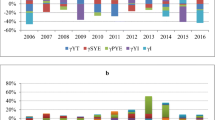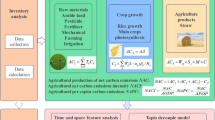Abstract
In this study, carbon emissions from agricultural energy consumption (CEAEC) are fully analyzed using data from the Yangtze River Economic Belt (YEB) between 2000 and 2017. First, generalized LMDI is adopted to decompose the drivers of CEAEC into five components. Then, the decoupling indicator and the decoupling effort indicator are constructed to quantify the decoupling degrees and examine the government's emission reduction efforts, respectively. The results show that (1) CEAEC in the YEB has shown a phased increase, reaching a peak at 1732.25104t in 2012. Except for some decreases found in Shanghai, Chongqing, and Guizhou, it is shown that all provinces' CEAEC have risen to varying degrees. In contrast, the intensity of CEAEC in the YEB has been declining since 2005. (2) The economic output effect acts as the major contributor to the growth of CEAEC, followed by the population effect. In contrast, both the energy intensity effect and the energy structure effect are the primary reasons for reductions in CEAEC. The spatial difference in CEAEC in the YEB increased significantly from 2000 to 2017. (3) There was an alternating change from decoupling to coupling and then to negative decoupling from 2000 to 2017. Based on the conclusions mentioned above, it is proposed that the formulation of low-carbon agricultural development strategies should consider the structural adjustment of agricultural energy consumption and the advancements of agricultural technology.







Similar content being viewed by others
Data availability
Data will be available if necessary.
References
Ang, B. W. (2004). Decomposition analysis for policymaking in energy: Which is the preferred method? Energy Policy, 32(9), 1131–1139. https://doi.org/10.1016/S0301-4215(03)00076-4
Ang, B. W. (2015). LMDI decomposition approach: A guide for implementation. Energy Policy, 86, 233–238. https://doi.org/10.1016/j.enpol.2015.07.007
Ang, B. W., Xu, X., & Su, B. (2015). Multi-country comparisons of energy performance: The index decomposition analysis approach. Energy Economics, 47, 68–76. https://doi.org/10.1016/j.eneco.2014.10.011
Asumadu-Sarkodie, S., & Owusu, P. A. (2017). The impact of energy, agriculture, macroeconomic and human-induced indicators on environmental pollution: Evidence from Ghana. Environmental Science and Pollution Research, 24(7), 6622–6633. https://doi.org/10.1007/s11356-016-8321-6
Bennetzen, E. H., Smith, P., & Porter, J. R. (2016). Decoupling of greenhouse gas emissions from global agricultural production: 1970–2050. Global Change Biology, 22(2), 763–781. https://doi.org/10.1111/gcb.13120
Castesana, P. S., Vázquez-Amábile, G., Dawidowski, L. H., & Gómez, D. R. (2020). Temporal and spatial variability of nitrous oxide emissions from agriculture in Argentina. Carbon Management. https://doi.org/10.1080/17583004.2020.1750229
Chen, J., Cheng, S., & Song, M. (2018). Changes in energy-related carbon dioxide emissions of the agricultural sector in China from 2005 to 2013. Renewable and Sustainable Energy Reviews, 94, 748–761. https://doi.org/10.1016/j.rser.2018.06.050
Chen, X., Shuai, C., Wu, Y., & Zhang, Y. (2020a). Analysis on the carbon emission peaks of China’s industrial, building, transport, and agricultural sectors. Science of the Total Environment, 709, 135768. https://doi.org/10.1016/j.scitotenv.2019.135768
Chen, X., Shuai, C., Zhang, Y., & Wu, Y. (2020b). Decomposition of energy consumption and its decoupling with economic growth in the global agricultural industry. Environmental Impact Assessment Review, 81, 106364. https://doi.org/10.1016/j.eiar.2019.106364
Colinet Carmona, M. J., & Román Collado, R. (2016). LMDI decomposition analysis of energy consumption in Andalusia (Spain) during 2003–2012: The energy efficiency policy implications. Energy Efficiency, 9(3), 807–823. https://doi.org/10.1007/s12053-015-9402-y
De Boer, P., & Rodrigues, J. F. (2020). Decomposition analysis: When to use which method? Economic Systems Research, 32(1), 1–28. https://doi.org/10.1080/09535314.2019.1652571
Diakoulaki, D., & Mandaraka, M. (2007). Decomposition analysis for assessing the progress in decoupling industrial growth from CO2 emissions in the EU manufacturing sector. Energy Economics, 29(4), 636–664. https://doi.org/10.1016/j.eneco.2007.01.005
Ding, X., Cai, Z., Xiao, Q., & Gao, S. (2019). A study on the driving factors and spatial spillover of carbon emission intensity in the Yangtze River economic belt under double control action. International Journal of Environmental Research and Public Health, 16(22), 4452. https://doi.org/10.3390/ijerph16224452
Fei, R., & Lin, B. (2017). Estimates of energy demand and energy saving potential in China’s agricultural sector. Energy, 135, 865–875. https://doi.org/10.1016/j.energy.2017.06.173
Han, H., Zhong, Z., Guo, Y., Xi, F., & Liu, S. (2018). Coupling and decoupling effects of agricultural carbon emissions in China and their driving factors. Environmental Science and Pollution Research, 25(25), 25280–25293. https://doi.org/10.1007/s11356-018-2589-7
He, R., Shao, C., Shi, R., Zhang, Z., & Zhao, R. (2020). Development trend and driving factors of agricultural chemical fertilizer efficiency in China. Sustainability, 12(11), 4607. https://doi.org/10.3390/su12114607
Huang, X., Xu, X., Wang, Q., Zhang, L., Gao, X., & Chen, L. (2019). Assessment of agricultural carbon emissions and their spatiotemporal changes in China, 1997–2016. International Journal of Environmental Research and Public Health, 16(17), 3105. https://doi.org/10.3390/ijerph16173105
IPCC. (2014). Climate change 2014: Synthesis report. Contribution of Working Groups I, II and III to the Fifth Assessment Report of the Intergovernmental Panel on Climate Change [Core Writing Team, R.K. Pachauri and L.A. Meyer (eds.)]. IPCC, Geneva, Switzerland, 151 pp.
Jiang, M., Hu, X., Chunga, J., Lin, Z., & Fei, R. (2020). Does the popularization of agricultural mechanization improve energy-environment performance in China’s agricultural sector? Journal of Cleaner Production, 276, 124210. https://doi.org/10.1016/j.jclepro.2020.124210
Karakaya, E., Bostan, A., & Özçağ, M. (2019). Decomposition and decoupling analysis of energy-related carbon emissions in Turkey. Environmental Science and Pollution Research, 26(31), 32080–32091. https://doi.org/10.1007/s11356-019-06359-5
Li, T., Baležentis, T., Makutėnienė, D., Streimikiene, D., & Kriščiukaitienė, I. (2016). Energy-related CO2 emission in European Union agriculture: Driving forces and possibilities for reduction. Applied Energy, 180, 682–694. https://doi.org/10.1016/j.apenergy.2016.08.031
Li, W., Ou, Q., & Chen, Y. (2014). Decomposition of China’s CO2 emissions from agriculture utilizing an improved Kaya identity. Environmental Science and Pollution Research, 21(22), 13000–13006. https://doi.org/10.1007/s11356-014-3250-8
Lipper, L., Thornton, P., Campbell, B. M., Baedeker, T., Braimoh, A., Bwalya, M., Caron, P., Cattaneo, A., Garrity, D., & Henry, K. (2014). Climate-smart agriculture for food security. Nature Climate Change, 4(12), 1068–1072. https://doi.org/10.1038/nclimate2437
Long, D. J., & Tang, L. (2021). The impact of socio-economic institutional change on agricultural carbon dioxide emission reduction in China. PLoS ONE, 16(5), e0251816. https://doi.org/10.1371/journal.pone.0251816
Long, X., Luo, Y., Wu, C., & Zhang, J. (2018). The influencing factors of CO2 emission intensity of Chinese agriculture from 1997 to 2014. Environmental Science and Pollution Research, 25(13), 13093–13101. https://doi.org/10.1007/s11356-018-1549-6
Luo, Y., Long, X., Wu, C., & Zhang, J. (2017). Decoupling CO2 emissions from economic growth in agricultural sector across 30 Chinese provinces from 1997 to 2014. Journal of Cleaner Production, 159, 220–228. https://doi.org/10.1016/j.jclepro.2017.05.076
Lynch, J. (2019). Availability of disaggregated greenhouse gas emissions from beef cattle production: A systematic review. Environmental Impact Assessment Review, 76, 69–78. https://doi.org/10.1016/j.eiar.2019.02.003
Ma, X., Wang, C., Dong, B., Gu, G., Chen, R., Li, Y., Zou, H., Zhang, W., & Li, Q. (2019). Carbon emissions from energy consumption in China: its measurement and driving factors. Science of the Total Environment, 648, 1411–1420. https://doi.org/10.1016/j.scitotenv.2018.08.183
Nwaka, I. D., Nwogu, M. U., Uma, K. E., & Ike, G. N. (2020). Agricultural production and CO2 emissions from two sources in the ECOWAS region: New insights from quantile regression and decomposition analysis. Science of the Total Environment, 748, 141329. https://doi.org/10.1016/j.scitotenv.2020.141329
Peng, Z., & Wu, Q. (2020). Evaluation of the relationship between energy consumption, economic growth, and CO2 emissions in China’transport sector: The FMOLS and VECM approaches. Environment, Development and Sustainability, 22(7), 6537–6561. https://doi.org/10.1007/s10668-019-00498-y
Pieper, M., Michalke, A., & Gaugler, T. (2020). Calculation of external climate costs for food highlights inadequate pricing of animal products. Nature Communications, 11(1), 6117. https://doi.org/10.1038/s41467-020-19474-6
Qi, X., Huang, X., Song, Y., Chuai, X., Wu, C., & Wang, D. (2021). The transformation and driving factors of multi-linkage embodied carbon emission in the Yangtze River Economic Belt. Ecological Indicators, 126, 107622. https://doi.org/10.1016/j.ecolind.2021.107622
Qian, Y., Cao, H., & Huang, S. (2020). Decoupling and decomposition analysis of industrial sulfur dioxide emissions from the industrial economy in 30 Chinese provinces. Journal of Environmental Management, 260, 110142. https://doi.org/10.1016/j.jenvman.2020.110142
Rebolledo-Leiva, R., Angulo-Meza, L., Iriarte, A., & González-Araya, M. C. (2017). Joint carbon footprint assessment and data envelopment analysis for the reduction of greenhouse gas emissions in agriculture production. Science of the Total Environment, 593–594, 36–46. https://doi.org/10.1016/j.scitotenv.2017.03.147
Ren, F.-R., Tian, Z., Chen, H.-S., & Shen, Y.-T. (2021). Energy consumption, CO2 emissions, and agricultural disaster efficiency evaluation of China based on the two-stage dynamic DEA method. Environmental Science and Pollution Research, 28(2), 1901–1918. https://doi.org/10.1007/s11356-020-09980-x
Román-Collado, R., & Morales-Carrión, A. V. (2018). Towards a sustainable growth in Latin America: A multiregional spatial decomposition analysis of the driving forces behind CO2 emissions changes. Energy Policy, 115, 273–280. https://doi.org/10.1016/j.enpol.2018.01.019
Shi, K., Yu, B., Zhou, Y., Chen, Y., Yang, C., Chen, Z., & Wu, J. (2019). Spatiotemporal variations of CO2 emissions and their impact factors in China: A comparative analysis between the provincial and prefectural levels. Applied Energy, 233, 170–181. https://doi.org/10.1016/j.apenergy.2018.10.050
Song, Y., & Zhang, M. (2017). Using a new decoupling indicator (ZM decoupling indicator) to study the relationship between the economic growth and energy consumption in China. Natural Hazards, 88(2), 1013–1022. https://doi.org/10.1007/s11069-017-2903-6
Sun, H., Edziah, B. K., Kporsu, A. K., Sarkodie, S. A., & Taghizadeh-Hesary, F. (2021). Energy efficiency: The role of technological innovation and knowledge spillover. Technological Forecasting & Social Change, 167, 120659. https://doi.org/10.1016/j.techfore.2021.120659
Sun, H., Kporsu, A. K., Taghizadeh-Hesary, F., & Edziah, B. K. (2020). Estimating environmental efficiency and convergence: 1980 to 2016. Energy, 208, 118224. https://doi.org/10.1016/j.energy.2020.118224
Tapio, P. (2005). Towards a theory of decoupling: Degrees of decoupling in the EU and the case of road traffic in Finland between 1970 and 2001. Transport Policy, 12(2), 137–151. https://doi.org/10.1016/j.tranpol.2005.01.001
Tian, Y., Zhang, J., & He, Y. (2014). Research on spatial-temporal characteristics and driving factor of agricultural carbon emissions in China. Journal of Integrative Agriculture, 13(6), 1393. https://doi.org/10.1016/S2095-3119(13)60624-3
Wang, H., Ang, B., & Su, B. (2017). Assessing drivers of economy-wide energy use and emissions: IDA versus SDA. Energy Policy, 107, 585–599. https://doi.org/10.1016/j.enpol.2017.05.034
Wang, Q., Li, R., & Jiang, R. (2016). Decoupling and decomposition analysis of carbon emissions from industry: A case study from China. Sustainability, 8(10), 1059. https://doi.org/10.3390/su8101059
Wang, Q., & Su, M. (2020). Drivers of decoupling economic growth from carbon emission—an empirical analysis of 192 countries using decoupling model and decomposition method. Environmental Impact Assessment Review, 81, 106356. https://doi.org/10.1016/j.eiar.2019.106356
Wang, R., & Feng, Y. (2021). Research on China’s agricultural carbon emission efficiency evaluation and regional differentiation based on DEA and Theil models. International Journal of Environmental Science and Technology, 18(6), 1453–1464. https://doi.org/10.1007/s13762-020-02903-w
Wang, R., Zheng, X., Wang, H., & Shan, Y. (2019). Emission drivers of cities at different industrialization phases in China. Journal of Environmental Management, 250, 109494. https://doi.org/10.1016/j.jenvman.2019.109494
Wang, W., Liu, X., Zhang, M., & Song, X. (2014). Using a new generalized LMDI (logarithmic mean Divisia index) method to analyze China’s energy consumption. Energy, 67, 617–622. https://doi.org/10.1016/j.energy.2013.12.064
Wang, X., Wei, Y., & Shao, Q. (2020a). Decomposing the decoupling of CO2 emissions and economic growth in China’s iron and steel industry. Resources, Conservation and Recycling, 152, 104509. https://doi.org/10.1016/j.resconrec.2019.104509
Wang, Y., Chen, W., Kang, Y., Li, W., & Guo, F. (2018). Spatial correlation of factors affecting CO2 emission at provincial level in China: A geographically weighted regression approach. Journal of Cleaner Production, 184, 929–937. https://doi.org/10.1016/j.jclepro.2018.03.002
Wang, Y., Yan, Q., Li, Z., Baležentis, T., Zhang, Y., Gang, L., & Streimikiene, D. (2020b). Aggregate carbon intensity of China’s thermal electricity generation: The inequality analysis and nested spatial decomposition. Journal of Cleaner Production, 247, 119139. https://doi.org/10.1016/j.jclepro.2019.119139
Xiong, C., Chen, S., Gao, Q., & Xu, L. (2020). Analysis of the influencing factors of energy-related carbon emissions in Kazakhstan at different stages. Environmental Science and Pollution Research, 27(29), 36630–36638. https://doi.org/10.1007/s11356-020-09750-9
Xiong, C., Yang, D., & Huo, J. (2016). Spatial-temporal characteristics and LMDI-based impact factor decomposition of agricultural carbon emissions in Hotan Prefecture, China. Sustainability, 8(3), 262. https://doi.org/10.3390/su8030262
Xu, B., Chen, W., Zhang, G., Wang, J., Ping, W., Luo, L., & Chen, J. (2020). How to achieve green growth in China’s agricultural sector. Journal of Cleaner Production, 271, 122770. https://doi.org/10.1016/j.jclepro.2020.122770
Xu, S.-C., He, Z.-X., & Long, R.-Y. (2014). Factors that influence carbon emissions due to energy consumption in China: Decomposition analysis using LMDI. Applied Energy, 127, 182–193. https://doi.org/10.1016/j.apenergy.2014.03.093
Yu, Y., Jiang, T., Li, S., Li, X., & Gao, D. (2020). Energy-related CO2 emissions and structural emissions’ reduction in China’s agriculture: An input–output perspective. Journal of Cleaner Production, 276, 124169. https://doi.org/10.1016/j.jclepro.2020.124169
Zhang, L., Pang, J., Chen, X., & Lu, Z. (2019). Carbon emissions, energy consumption and economic growth: Evidence from the agricultural sector of China’s main grain-producing areas. Science of the Total Environment, 665, 1017–1025. https://doi.org/10.1016/j.scitotenv.2019.02.162
Zhang, S., Kharrazi, A., Yu, Y., Ren, H., Hong, L., & Ma, T. (2021). What causes spatial carbon inequality? Evidence from China’s Yangtze River economic Belt. Ecological Indicators, 121, 107129. https://doi.org/10.1016/j.ecolind.2020.107129
Zhao, R., Liu, Y., Tian, M., Ding, M., Cao, L., Zhang, Z., Chuai, X., Xiao, L., & Yao, L. (2018). Impacts of water and land resources exploitation on agricultural carbon emissions: The water-land-energy-carbon nexus. Land Use Policy, 72, 480–492. https://doi.org/10.1016/j.landusepol.2017.12.029
Acknowledgements
Funding was provided by National Natural Science Foundation of China (Grant No. 71704068).
Funding
The financial assistance provided by the National Natural Science Foundation of China (71704068; 72174076; 71774071); MOE (Ministry of Education in China) Project of Humanities and Social Sciences (21YJCZH139); National Key Research and Development Project of China (2017YFC0404600); the China Postdoctoral Science Foundation (2017M621621); National Statistical Science Research Project (2021LY055); Jiangsu Soft Science Research Project (BR2021030); Zhenjiang Soft Science Research Project (RK2021010); the Academic Research Project of Jiaxing University (ICCPR2021007), and Key Research Base of Universities in Jiangsu Province for Philosophy and Social Science “Research Center for Green Development and Environmental Governance” is highly appreciated by researchers of this study. The views and opinions expressed in this article are those of the authors and do not necessarily reflect the views of the funding agencies.
Author information
Authors and Affiliations
Contributions
DS and SC contributed to conceptualization. JG contributed to methodology, CZ to software, XY to validation, and ZC and HS to formal analysis. DS and SC carried out investigation, and SC performed data curation. JG and XY contributed to writing—original draft preparation. All authors have read and agreed to the published version of the manuscript.
Corresponding author
Additional information
Publisher's Note
Springer Nature remains neutral with regard to jurisdictional claims in published maps and institutional affiliations.
Rights and permissions
About this article
Cite this article
Sun, D., Cai, S., Yuan, X. et al. Decomposition and decoupling analysis of carbon emissions from agricultural economic growth in China's Yangtze River economic belt. Environ Geochem Health 44, 2987–3006 (2022). https://doi.org/10.1007/s10653-021-01163-y
Received:
Accepted:
Published:
Issue Date:
DOI: https://doi.org/10.1007/s10653-021-01163-y




